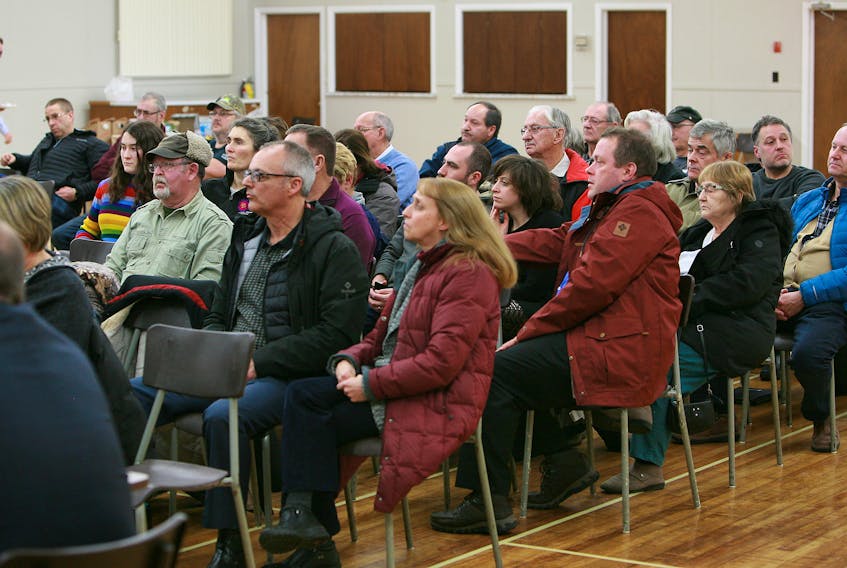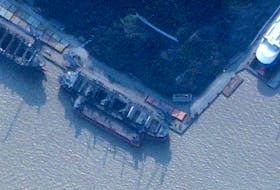SAULNIERVILLE, NS – More than 60 people turned out for the first public meeting in phase one of the Clare boundary review consultation process.
At least 10 people from the audience shared their thoughts, some prepared and some not, some defending the idea of a small council, but the majority speaking out about the importance of maintaining the status quo of an eight-member council.
The Jan. 16 meeting began with a presentation delivered by John Heseltine, the senior planner from Stantec, the Dartmouth-based consulting agency hired to oversee the review process. Heseltine opened his comments with several apologies, the first being that he doesn’t speak French so the meeting was conducted almost entirely in English, a fact that was not well-received by some members of the gathered crowd. The consultant also apologized on behalf of the eight council members currently sitting on council.
“They discussed it and decided not to come so people could say what was on their minds without them being present,” Heseltine said, a comment that sent another ripple through the crowd.

SURVEY RESULTS
Between Dec. 18 and Jan. 14, community members were asked to respond to a survey prepared by Stantec, that was available both online and in print form.
Heseltine said 540 Clare residents from 34 communities within the district had responded to the survey that asked specific questions about council size and weighted the importance of cost savings, service to the community and effectiveness of council.
“This was a very, very good response,” he said. “In percentage terms, this is the best survey we’ve ever run.”
Heseltine showed graphs that compared the District of Clare to the other 21 rural municipalities in the province, demonstrating that Clare’s geographic poll divisions mean each councilor is responsible for 106.6 square kilometres, the second smallest area of rural municipalities and that each councilor is responsible for 1,002 constituents, with the average being 1,600.
“Both of those numbers would point towards Clare having a smaller council,” Heseltine said. “However, what matters here is public opinion.”
When Heseltine spoke to the survey results, it appeared clear that most respondents would prefer to see the status quo – with 55.4 per cent of respondents opting to keep at least eight or even more councillors and 44.6 per cent preferring a council of seven members or fewer.
What was also clear from the survey was that more than half of the respondents felt a smaller council would save money, however the research Stantec completed showed that Clare councillors are paid about $300 less than could be expected based on a rural salary per constituent basis.

OPINIONS FROM THOSE WHO ATTENDED MEETING
The survey results were close enough to bring on a few passionate exchanges as the evening progressed. The first scheduled speaker of the evening was Jean Melanson, former warden of Clare and a 30-year council veteran. He quickly made his position clear.
“The status quo has worked well and is still working well,” Melanson said, adding that in all of his years of knocking on doors and talking to citizens during campaigns, the size of council was never once raised as an issue.
Longtime Université Sainte Anne professor and current Vice Chair of Academic and Research Kenneth Deveau made it clear he was speaking at the meeting for himself and not on behalf of the university. Deveau expressed support for either the status quo or an even larger council that could withstand outside pressures and lobby groups, but Deveau also said instead of numbers, the community should be looking at how they could improve the council they have, especially on a gender and linguistic basis. Deveau also stated that he didn’t like the fact that he was being forced to translate his prepared words into English on the fly in a Francophone community.

“I shouldn’t have to speak in English here today,” Deveau said. “If we don’t carve out a place for French in Nova Scotia, no one else will.”
Deveau also asked if the consulting agency would provide two alternative boundary maps for citizens to view during the second meeting stage, stating it would be easier for people to make a decision when they have the two drawings to compare and could see what the changes would look like.
Dr. Michel Comeau, a local dentist, started out by saying he wanted to thank the Clare Civic Association, not because he agreed with them, but because they’d managed to create an interest in municipal politics in Clare.
“I’m not sure of the value of spending $30,000 to do that, but hopefully this process will eventually lead to more effective representation,” Comeau said.

Comeau pointed out several great things Clare council had achieved through the years including the medical centre that he said is a model for rural Nova Scotia, but he had harsh words for the civic association, labeling it a “secretive shadow council.
“Overall, I think we’re doing pretty darn good,” Comeau said. “We’re still losing some people, but we also have new people moving into Clare, it’s not all doom and gloom here.
“I don’t think five council members is a solution, and I don’t think a group that has six active members should be dictating to the rest of us,” Comeau said, before asking that the community shift its focus to tackling some of the problems being faced like employment, youth retention and growing the local economy.
Gerard Theriault, chairperson of the Clare Civic Association immediately responded to Comeau’s comments.
“We only had six members at the meeting with John Heseltine,” Theriault said. “But we’re an association of 25 people. That’s pretty good.”

Other speakers also voiced concerns about having a smaller representation on council, including Evelyn LeBlanc-Joyce, who was representing Société acadienne de Clare at the meeting. She spoke passionately about the protection of the Acadian culture and how the society’s position had not changed during the three boundary review processes.
“We know we can live and prosper here in French,” LeBlanc-Joyce said. “We’ve had the right to do that for 250 years so we’re hyper aware of anything that might endanger our rights to continue to do so. Having to go through this process for the third time in four years is very tiring and having to do this presentation in English feels like a violation of those rights.”
LeBlanc-Joyce said her organization would like to see the status quo or an even larger number of councillors.
“We need to strengthen our municipal structure, not diminish it,” she said.
Kristanne Chandler, also a member of the Clare Civic Association, stood up to state she felt the conversation had drifted off course.
“We’re here to discuss the number of people on council,” Chandler said. “Our French identity will not change no matter what the size of our council. This is an important process, and yes, this is the third time we’re here completing this process. But if we’d had the proper survey and the proper consultation process the first time, we residents wouldn’t have to keep doing this.”
Chandler added that she believed a smaller council would be forced to consult with people more often, and therefore offer more meaningful engagement.

After the meeting closed, Theriault repeated a statement he had made in an earlier interview.
“We will agree with whatever decision the community decides,” Theriault said, but he also admitted he’d expected a stronger showing for a smaller council in the survey. “But it was close – that 55 to 44. It was very close.”
Heseltine said afterwards that the mandate he was left with was not as clear as he’d expected it would be going in.
“I guess I was hoping the audience could tell me, ‘We want to do this specifically’. I didn’t get that direction, but I think there’s enough in the comments that people have made to go along with the survey information that I already had,” said Heseltine.
Overall, he felt the meeting was positive, had a great turnout and offered good comments. He said his next step would be to discuss the meeting and survey results with the municipality.
When told Theriault thought the results were “close” Heseltine responded, “I don’t know if I’d call it close – but 55 to 44 is also not overwhelming – there is room to consider or have another look – and since there was some direction from the audience, that might be a healthy thing to do.”
Heseltine said they will most likely draw out boundary scenarios for Clare showing the eight existing council members, but also complete a second one showing five, since that number was the second largest response request in the survey results.
“It’s a bit more work, but normally that’s what we do, offer two different suggestions,” Heseltine said. “Usually the information isn’t as good as we have in this case – but we had such good results from the survey that we have a lot more guidance than we normally would have.”
Gerard Theriault responded further by email the following day.
“Last evening we had nine members at the review meeting, which is very good,” he said. “We are not a secret association, as all people in Clare can join and would be welcome. We only protect the privacy of our members for a good reason… as you know by now, we are a very small community and sometimes it is better to protect your identity.”

When reached by email the following day, Ronnie LeBlanc, Clare warden, reaffirmed his council’s commitment to the process and further explained their absence.
“Council is committed to the boundary review process and would very much have enjoyed taking part in last night’s discussion. However, following a discussion with both Stantec and the CAO, it was felt Council’s absence might encourage a more open dialogue on the issue of Council size and appropriate representation,” LeBlanc stated.
Asked about the survey results, LeBlanc wrote the following:
“I am pleased with the results of the process thus far. The response to the survey exceeded my expectations and appeared evenly distributed amongst municipal districts and age groups. This tells me the public is engaged. I look forward to the next phase of the process and what Stantec proposes in terms of boundary scenarios.”
According to Heseltine, a second phase public meeting to discuss the proposed boundary scenarios will be held in about three weeks time, with the actual meeting date to be announced.









